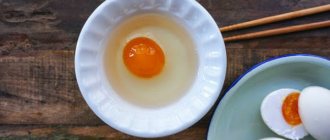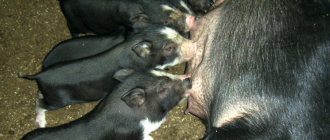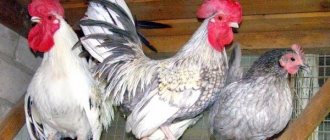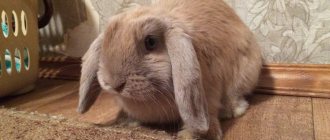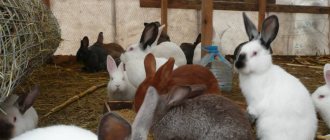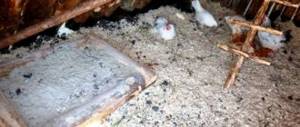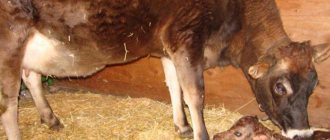Why does a cow give milk to a person?
A cow is a mammal, which means that after birth, the calf at the beginning of its life will feed on milk from its udder. In nature, the calf feeds uncontrollably from the heifer until nine to ten months. On farms, babies must be separated from their mother immediately so as not to create a stressful situation for the animals later.
Next, the cow must be milked by hand, feeding part of the milk to the baby, the rest can be used for food and for preparing dairy products for humans. The calf continues to be fed for 3-4 months, gradually transferring it to the usual food of large horned animals. You should strive to milk the cow for as long as possible, until she becomes pregnant again, that is, becomes pregnant. During this period, milking stops for two months.
Now let's explain why you can't milk a cow for too long. As a rule, an animal calves once a year, therefore, it can produce milk for an average of ten months. If the heifer remains dry, that is, does not become pregnant, milking can be extended for up to two years, but the quantity and quality of the product will decrease.
What to do if a cow kicks while milking
Even if a cow struggles during milking and doesn’t want to let anyone near her, she still needs to be milked. Otherwise, mastitis may develop. Therefore, the problem needs to be resolved as quickly as possible.
First of all, you should examine the udder and nipples for injuries, cracks, bruises, insect bites, and signs of inflammation. If such pathologies with the mammary gland are detected, all measures must be taken to eliminate them
During the treatment period, the cow should be milked very carefully, without causing her unnecessary suffering.
A cow can kick during milking for a number of other reasons, which should be eliminated in time by the following actions:
- determine an exact milking schedule and strictly adhere to it;
- before starting the procedure, you can distract the animal with tasty food - crushed grain, vegetables;
- use special lubricants for the udder and nipples so as not to dry out the skin;
- place a damp cloth on the cow’s back, which will calm and distract the animal;
- use correct milking technique that does not cause discomfort;
- During the milking process, you should speak kindly to the animal, stroke it, and also ensure a calm environment and turn on dim lights.
Attention! If it is determined that during milking the cow is kicking not as a result of an inflammatory disease of the udder, soothing decoctions or mild sedatives can be used. If none of the options solve the problem, the cow continues to kick, many experienced cattle breeders tie her limbs. This will help make the milk collection procedure as safe as possible for humans.
The knot should not be made tight; it should be tied in a figure eight. At the same time, they approach the cow from the front. If the animal does not allow a person to approach it at all, kicks and fights, you can form a loop on the rope in advance and grab the forelimb into it, lift it up and secure it. After 4-5 such fixations, the individual gets used to the procedure and then perceives it calmly
This will help make the milk collection procedure as safe as possible for humans. The knot should not be made tight; it should be tied in a figure eight. At the same time, they approach the cow from the front. If the animal does not allow a person to approach it at all, kicks and fights, you can form a loop on the rope in advance and grab the forelimb into it, lift it up and secure it. After 4-5 such fixations, the individual gets used to the procedure and then perceives it calmly
If none of the options solve the problem, the cow continues to kick, many experienced cattle breeders tie her limbs. This will help make the milk collection procedure as safe as possible for humans. The knot should not be made tight; it should be tied in a figure eight. At the same time, they approach the cow from the front. If the animal does not allow a person to approach it at all, kicks and fights, you can form a loop on the rope in advance and grab the forelimb into it, lift it up and secure it. After 4-5 such fixations, the individual gets used to the procedure and then perceives it calmly.
Many cattle breeders use special devices made of galvanized or stainless steel on their farms for kicking cows - anti-kicking devices. The device is universal, its size is easy to adjust. It's easy to use. With the help of such a device, the hind limbs of the cow are securely fixed.
You can make such a unit yourself. For this you will need a pair of curved pipes of the same size and shape. They should have holes in the middle. You also need to prepare a concave tube with a larger diameter than the previous ones, springs, and rubber caps. A spring is inserted into a tube of one type. Those tubes with a smaller diameter are inserted into the concave one in turn. Caps are placed on the edges.
Using anti-kick is very simple. Its lower part is attached to the front limb of a kicking cow. Use a button to adjust the length so that the second end of the device can be secured to the back. In this case, the cow's limb is raised. In this position, the animal cannot kick, and milking proceeds calmly. The hind limb can be fixed in the same way.
Why does a cow beat while milking?
Before calming a cow using various means, you need to understand why she behaves this way. There may be such factors for the female’s poor reaction when they try to milk her:
- improper milking and udder massage, which causes the cattle to feel pain. This happens often, especially if a person has a cow for the first time;
- animal stress. A cow may kick due to great anxiety associated with transportation to a new place of residence, due to the fact that there are new animals and new people around;
- During milking, external stimuli may be present: too bright light, sharp sounds, loud noise, etc.;
- the animal at that moment may simply be overly tired and therefore irritable;
- the female kicks when there are wounds, scratches, cracks on the nipples or when the udder is bitten by insects;
- Also, one of the reasons may be mastitis or other inflammations of the udder. At any stage of this disease, the cow feels pain in the mammary glands;
- Cattle can also kick during milking due to the banal lack of a clear daily routine and milking schedule. The animal cannot get used to this procedure and resists every time.
You should also take into account such a factor as the youth of the animal; in this case, you need to be patient and accustom the cow.
How to milk a cow after a forced start
So, the cow has not been milked for several days, which is why there is less milk. But the udder still hurts, so milking such a cow is not easy. The animal is milked 2-3 times a day: if the cow twitches, it means that it is still in pain, perhaps mastitis has begun. If the situation does not improve, you should call a veterinarian.
If a cow reacts calmly to milking, but gives less milk, she needs to be well fed: highly concentrated and juicy feed, sugar beets, potatoes, etc. She should also be given more water. Most likely, it will not be possible to return to the previous level of milk production.
After a forced start, the milk is thrown out within a few days, even if it looks and smells normal. If the milk is curdled, with clots, blood or an unpleasant odor, you need to call a veterinarian.
Cow eats soil
It all depends on the amount of soil eaten and the drinking regime. Right now I have a cow that regularly eats little by little soil, regardless of physiological stages, throughout her life.
It was not possible to establish a relationship between the cow's needs and her consumption of soil. Monitoring her condition did not reveal any negative impact on her well-being. Eating is uniform throughout the entire time and moderate in quantity.
There are no other symptoms of perverted appetite, so I don’t take any measures to wean or prohibit it. The cows have water all the time.
Important(!): It is always necessary to check the cleanliness of succulent feed so that there is no dirt, soil or sand. The cow already takes over some amount of land in the pasture, there is no need to increase the load on the gastrointestinal tract
Why does a cow need to be milked regularly?
To obtain the maximum amount of milk, the cow must be milked regularly and in compliance with all necessary rules.
With proper organization of this process on a farm, the amount of milk yield will quickly increase. If you do not milk the cow several times and do not monitor the regularity of milking, the following problems may arise:
- reduction in milk production;
- mastitis;
- sepsis;
- death.
In addition, a milked cow experiences physical pain and agony, mooing and suffering. If a heifer is not milked on time and to the end, its quality as a milking animal deteriorates. After the next calving, she will produce much less milk.
The remaining milk burns out and its quantity will undoubtedly begin to decrease at milk yield, since part of it in the udder remains unclaimed. A poorly milked or under-milked animal has every chance of developing mastitis; it is this disease that is the real scourge of cattle during milk production.
The udder swells, becomes painful and swollen, and the heifer may develop a fever. The milk will contain clots and purulent discharge, making it impossible to eat due to the use of antibiotics or other medications. All this happens over a long period until complete recovery.
If mastitis is not treated, there is a high risk that the disease will develop into sepsis. Then everything could end in death. Given such a serious danger, I always strive not to leave a single extra drop of milk in the udder.
If you treat your cow nurse with care, strive for regular milking, quality care and maintenance of the animal after calving, all these factors will undoubtedly bear fruit.
If, with the help of our article, you have figured out the problems that arise from irregular milking of a cow, please like it.
Write a comment if you have experience in this matter.
If you don't milk the cows
In the wild, a cow's body adapts to producing a certain amount of milk. The calf feeds freely when it feels hungry or smells milk. Feeding a calf in the wild continues until 9-11 months, then it switches entirely to adult food: grass, leaves, branches. The lactation period of a cow that lives in the wild gradually ceases. The udder stops producing milk until the next calving, so she does not experience any complications.
A cow is treated differently at home. The animal is purchased to produce milk, so they try to extend its lactation period as long as possible. The animal must be milked 2 hours after calving. At first, milking is carried out every 2-3 hours. In this case, the udder is completely released. You should not allow milk to stagnate in the mammary gland. The consequences can be severe. It is necessary to accustom the animal's body to constant milk production. Frequent approaches during the milking period help increase productivity.
The mammary gland consists of glandular tissue. It contains alveoli, in which milk is produced, milk tubules, through which liquid flows into larger channels - cisterns. The cisterns are connected to the nipple canals. From them milk is expressed.
Milk is produced from the blood, so the mammary gland has a good blood supply and a system of blood vessels. Milk is produced constantly and evenly throughout the day. If the udder is not cleared of fluid, it will accumulate, squeezing the capillaries and veins, which will affect not only productivity, but also the overall health of the animal.
More on the topic: How to treat low milk yield in cows?
If the udder is very full, fluid may spontaneously flow out of the nipples. This should not be allowed. The sweetish taste will attract insects that can bite the cow or cause infection. When fluid constantly leaks from the mammary gland, the nipples become dirty. The risk of pathological microflora entering the mammary gland increases.
The milk dries on the nipples, tightening the skin. Cracks appear on it, which can bleed. Pathogenic bacteria enter through the blood. They will lead to inflammation of the mammary gland and blood poisoning. The animal develops necrosis and it will be impossible to save it.
When the udder is full, the fluid puts pressure not only on the blood vessels and milk tubules, but also on the nerve endings. The cow is in severe pain. Starts to moo loudly. Approaching her to help is difficult at this time. She is showing aggression. What happens if you don’t milk a cow and miss only 1 approach? The following consequences may occur:
- development of pain syndrome;
- circulatory disorders;
- udder swelling;
- development of mastitis;
- the appearance of cracks in the skin;
- disruption of the sebaceous glands, which leads to furunculosis;
- change in animal behavior;
- decreased immunity;
- increased body temperature;
- refusal of food;
- decreased productivity.
If the milking regime is violated or absent, cows with high productivity especially suffer. Animals of meat breeds do not produce much milk, but it also needs to be expressed from the udder. The calf is not able to take all the milk.
Stagnation of fluid in the milk tubules will lead to complications. Reduce the number of milkings gradually. At the same time, they focus on reducing milk yield.
Why doesn't a cow give milk?
Sometimes it happens that a beloved cow stops producing milk or its production volume has decreased, although the animal was well looked after and did not miss milking. This can happen for several reasons:
- Stress factor. Changes in living conditions, changes in personnel (hands), inept milking - the animal can react negatively to all this, and milk yield will decrease or disappear altogether.
- Late launch. Often occurs due to ignorance of the real date of future calving.
- Latent chronic mastitis.
- New feed. During the adaptation period, the cow may reduce milk yield.
These are the most common causes of poor milk yield. In fact, there are a lot of them - from the banal “a cow wants a bull” to very real diseases that animals suffer as often as people. So if the cause cannot be determined, it is worth calling a veterinarian.
The fat content of milk depends on the massage - how to do it?
Massage is important for both manual and especially machine milking. Before putting on a cow milking machine, the home milker must ensure that the quality and volume of milk is at its best. Using your palms, slowly stroke the udder from all sides, width and length. Then a nipple massage is done. The nipple should be squeezed in a fist and the udder should be pushed up, just as a calf does. The strength of a calf's kick can be assessed by letting it drink from a bucket. Milk should not flow out of the nipples during the massage. Thanks to massage:
- milk volume increases;
- milk delivery becomes almost complete;
- milking speed increases;
- the fat content of milk increases.
After the massage, “allowance” occurs - a reflex swelling of the nipples and readiness to release milk. The first streams (2-3 from each nipple) should be expressed into a glass. This is a mandatory preventive measure to prevent the cow from losing milk. The milk in the glass is carefully inspected for the presence of unusual flakes, mucus, blood or purulent discharge. In case of any doubt, contact a veterinarian.
Types of milking machines
Machine milking works on the same principle, but the machines themselves are either 2-stroke or 3-stroke. The latter give better milk yield, since they have a vacuum pressure drop and have a pause mode - for animals such a unit is more comfortable, they are less likely to experience stress. The degree of automation of the devices varies; you can connect one cow to a portable one, or up to 20 at once. For large farms, there are milking systems designed for a number of two dozen to a hundred cows.
Today there are models on the market that are as close as possible to the natural process of milk collection. The devices are:
- Three-stroke - squeeze the nipple, express, rest, repeat the cycle.
- Asynchronous - milking first the posterior glands, then the anterior ones.
- Tact is a number equal to the sucking movements of the calf.
An equally important criterion when choosing is the type of motor, of which there are only two:
- Oil - quiet in operation, reasonable price, good for milking a large number of cows.
- Dry is more expensive than oil, is resistant to temperature changes, is lightweight, does not require maintenance and does not pollute the environment with emissions.
The classes of vacuum pumps are also different:
- Membrane - for several units of livestock, more often used in budget devices.
- Piston - not very convenient due to its large size, noise, and at the same time not the most durable.
- Rotary – almost silent.
We recommend reading: Breeding bulls for meat for beginners: at home, growing as a business, pros and cons, video
The milk extraction method for the units is vacuum. In milking machines, an electrically driven pump creates this vacuum depending on the settings on the pressure gauge and regulator, maintaining the required pressure during the process. The pneumatic pulsator delivers pulses; you can adjust the feed speed yourself.
What to do if a cow gives little milk
Normally, cows are milked 3 times a day: at six in the morning, at noon and at seven in the evening. Before the birth of calves, the pied cow is milked less - twice a day. Most often, interruptions in the amount of milk in cows are associated with the upcoming or past calving. Many people face the problem of how to milk a cow after calving. First of all, pay attention to how the animal eats. Her diet must include:
- tubers and root vegetables;
- good, preferably legume-cereal hay;
- concentrated feed (cakes, molasses);
- mineral supplements (salt, chalk, phosphates, bone meal).
After winter, an exhausted cow should not be milked. Normally, it takes about three months to bring a cattle to the three-time milking regime.
A natural decrease in milk yield in many animals is observed in the fall. This is usually associated with a change to dry food. Productivity can be increased by adding juicy products to the diet, such as beets, wet silage, and pulp. Often, feeding milk twice a day - crushed grain, boiled and diluted with water - allows you to increase the amount of milk. It is useful to regularly give your animal salt lick.
Not often, but there are cases when healthy pieds with a good appetite stop giving milk. The reasons usually remain unclear. In general, it can be argued that in order for the amount of milk to please the owners, the cow must be a favorite. Typically, calm and happy cows show the highest milk yields.
How many times a day is a cow milked?
What happens if you don't milk a cow at all? Today there are farms whose owners eat neither meat nor milk. Animals are kept for their own pleasure. The largest ones are most often horses, but there are also cows. They are not milked, and the cow does not have milk until the calf is born. Then she feeds him naturally - and the milk disappears.
But if a cow is kept in order to be milked, then the calf after birth is not allowed to suck the udder. Otherwise, he will then suck all the milk from his mother, even when he grows up. The cow is milked and a portion is given to the baby, the rest is taken by people for their own needs.
When the horned nurse has just calved, she is milked 4 times a day, for each then the number of milkings is reduced.
It is common practice to milk cows twice a day. There are farms and individual farms where cows are milked three times a day. It is estimated that this could result in a 6-7% increase in the bottom line. Is such an increase in milk yield worth the labor costs? This can only be determined by the situation.
Also, new farmers often ask what will happen to the cow if she is not milked in the morning or evening. Or, to put it another way, how many milkings can you skip without harming the animal?
First of all, you need to understand that cows in their natural habitat would never have such a quantity of milk. People specifically raise special breeds of cattle - dairy cattle, with high milk yields and large udder volumes. And if you miss even one milking, the cow will suffer: her udder will be full, it will hurt, and the cow will behave restlessly and moo.


